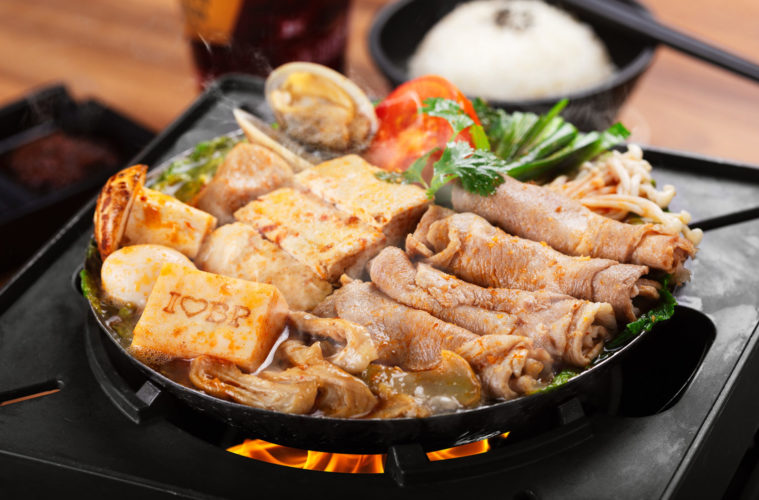Marbled meat, bundles of fresh vegetables, steaming broth, and dozens of fish ball and tofu varieties – there’s so much to love about hotpot and shabu, especially during the cooler months. Lucky for Irvine, three new hotpot restaurants are opening soon – Dai Mei Hot Pot, Nice to Meet You Hotpot and Shancheng Lameizi.
While hotpot and shabu have been enjoyed in China and Japan for centuries, the craze for both seems to have increased exponentially in Irvine just over the past few years. Hotpot and shabu have many similarities, but they are not exactly the same. For new diners, here is a quick breakdown of the two and how to enjoy them.

(dPot)
Hotpot, for the most part, is Chinese, although there are Korean options, while shabu is Japanese. Both of them feature boiling soups at the center of a table or a counter that diners use to cook their meals. Typically, hotpot places will have tables with special vats embedded in the center of the table, while shabu places will have a table with a stovetop and will place a bowl of soup on top of that. Both allow guests to cook their meals in front of them in the soup. Since you cook the food yourself, both are social dining experiences that last longer than your typical meal, similar to how KBBQ is a social experience.
Below is a beginner’s guide to help you find the right hotpot or shabu spot for you and how to enjoy your meal.
Choose the type of hotpot or shabu spot that works for you. Typically, all spots fall under one of four categories: a la carte, all you can eat, combo, and pre-selected bowls. Below are breakdowns of each category and which restaurants in Irvine offer this option.
- At a la carte spots, you order everything from meat, vegetables, noodles and sides individually, giving you the most control over your meals. While this allows guests to enjoy a wide variety of dishes, these spots are often the most expensive because the dishes rack up quickly.
Try this at: Chengdu Laozao Hotpot and Haidilao - All you can eat spots feature a wide variety of options that you can help yourself to. Typically, you order plates of meat that the waiter will bring by, while everything else is at a counter for you to choose from. Some restaurants include dishes like fried chicken, japchae, sushi and fried rice in the cost.
Try this at: All That Shabu, Dada Shabu Shabu Buffet, House of Shabu Shabu, and Oishi Shabu Shabu - Combo meals usually have you select a meat and then come with a veggie platter and a bowl of rice. You typically get to choose one noodle option as well such as ramen, udon or vermicelli.
Try this at: dPot, Miyabi, and Mokkoji - If you want an easier option, where everything is decided for you, a pre-selected bowl spot is the best option. The bowl comes with a selection of different meats, veggies and other toppings precooked. If you dine in, it’ll come in a hotpot bowl that keeps the soup boiling as you eat.
Try this at: Boiling Point, Haidilao and Peng Huo

(dPot)
Once, you’ve chosen a spot, the first step at any restaurant is to choose your broth. This broth will be used to cook everything you order, so be sure to pick something you won’t tire of. Typical broths for shabu include miso, tonkatsu, sukiyaki and a vegetarian option. Hotpot restaurants typically have a wider variety of broths to choose from including miso, tonkatsu, Sichuan spicy, tomato, kimchi and pork bone.
The next step is to choose your meat. This step doesn’t matter at all-you-can-eat spots, since you can try a little of everything and it’s included in the price, or at a la carte restaurants, since you can order multiple meats. But at combo and pre-selected bowls restaurants, this step is important because that meat will make up the core of your meal.
The fun part is that all these spots let you cook your meal right in front of you. Start by adding the items that’ll take longer to cook in the broth. These can be thick vegetables like carrots, mushrooms, and broccoli or cubes of tofu and dumplings. Once you’ve got those out of the way, all you have to do is swoosh your meat and leafy vegetables in the broth to cook it. The meat is cut very thinly, meaning that usually, two to three swooshes through the broth is enough to cook it. Before you eat anything, be sure to blow on it to cool it off.

All That Shabu (Photo by John Cho)
Most places will offer sauces on the side for you to dip your items in. The most common sauces are goma, a creamy sesame sauce that pairs well with meat, and ponzu, a citrusy soy sauce made with yuzu that goes great with vegetables. Make these sauces yours by adding grated garlic, chili oil, diced cilantro, or green onion slices. Depending on the restaurant, they will either provide the sauce at your table or have a sauce bar where you can mix your own.
Whether you opt for hot pot or shabu, these restaurants are great options for staying warm during the cooler months or for dinner with friends. And if it’s your first time trying this type of dining, consider checking out multiple of these spots to get a better feeling for hotpot and shabu.
Advertising disclosure: We may receive compensation for some of the links in our stories. Thank you for supporting Irvine Weekly and our advertisers.

